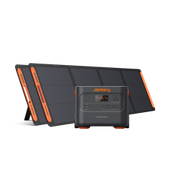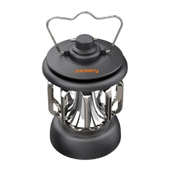Winters can be harsh for outdoor cats, and like anyone else, wind, cold temperatures, and snow or ice can lead to hypothermia and frostbite. If you don’t want this to happen, you must know how to keep outdoor cats warm. You can provide them water, food, and a shelter made of insulated materials, play with them, and wipe off the snow to keep them warm.
The best would be to provide an electric blanket, heating pad, or a thermal bed. To power them and other appliances for hours without worrying about hours of power outages and electric bills, you can opt for solar-powered portable power stations. Jackery Portable Power Stations are the leading battery backup solutions with sturdy, foldable handles and large battery capacity.
Key Takeaways
- Although the lowest temperature for cats depends on their breed and age, anything below 45 degrees Fahrenheit (7.2 degrees Celsius) can be uncomfortable.
- To keep outdoor cats warm during a freezing temperature, keep them in a well-insulated and warm shelter, wipe off the snow from their paws, stomach, and others, provide them extra food and water, and play with them.
- While keeping the cats warm, you must not keep towels, blankets, or folded newspaper in the shelter, keep anti-freezing solutions away, keep food and water bowls outside, protect the appliances, and avoid salt or other chemical melting products.
What Temperature is Too Cold for Outdoor Cats?
The lowest temperature for cats depends on multiple factors, such as age, breed, health, coat, and weather. However, as a thumb rule, a temperature below 45oF (7.2oC) can make any healthy cat uncomfortable, irrespective of their breed, age, or any other factors.
Besides, temperatures below 32oF (0oC) can cause cat hypothermia and frostbite. A cat's exact tolerance may depend on its type. For example, certain community cats may develop thicker coats to survive cold temperatures, while Norwegian Forest Cats are naturally built for that.
Tips for Keeping Outdoor Cats Warm
Irrespective of how adaptive outdoor cats are, they need help surviving winter, and you must look out for them. Here are a few helpful tips on how to keep outdoor cats warm in winter:
Bring them Indoors
If you can accommodate the outdoor cats at your residence, it will help them stay safe from frosty and chilly temperatures. However, if your house isn’t big enough to accommodate all, provide a shelter to keep them warm and ensure they have adequate access to unfrozen water.
Wipe off the Snow
Thoroughly wipe off the cat’s legs, paws, and stomach after they come in from snow, sleet, or ice. Cats can’t lick the paws by themselves, and it helps them keep warm by preventing ice crystals from forming between their toes, which potentially causes discomfort or pain, especially when the snow crystals melt and refreeze. Also, antifreeze or salt used in the sideways can be dangerous if ingested when they lick their paws.
Provide them with a Warm Place to Live
Try to provide the outdoor cats with a warm place to sleep, away from drafts and off the floor. You can create a cozy space by providing a snug bed and a warm towel or blanket. If the temperature drops very low, you can opt for alternate methods, such as using an electric towel, blanket, or oil heater.
An electric towel or blanket needs a power source. If it isn’t available in your garage or you prefer an alternate power source, then Jackery Portable Power Stations are a dependable solution.
However, ensure that the cats are supervised with electric blankets. They might get playful and chew down the wires or demonstrate similar behavior, which might cause short circuits and other damage.

Prepare an Outdoor DIY Winter Cat Shelter
Preparing an outdoor winter cat shelter is a great answer to how to keep outdoor cats at night. For that, take a Rubbermaid bin, cut an entry hole for the cats, keep it on a platform of bricks, and, depending on the temperature, insulate it by attaching a Styrofoam cup on the walls and floors.
Also, provide straw bedding inside the shelter so the cats don’t sleep on the cold floor. You can also keep a heated mat underneath the bedding to keep the cats warm and power them with a Jackery Portable Power Station.
Provide Extra Food
Winters can be challenging for your furry friends, especially if they live outdoors. Try to provide extra food to your cats during these times, as the ones outside in the cold may burn more energy to stay warm.
Routinely check the cat’s food dish to make sure it stays unfrozen. Also, use plastic bowls instead of metal, as your cat’s tongue can stick to the metal at low temperatures.
Moisturize the Skin
Cats often experience dry, itchy skin during winter, and to keep that in check, try feeding them wet food with a hint of liquid fish oil. It helps them stay moisturized inside out and comfortable on a chilly winter afternoon.
Provide Fresh Water Frequently
Many animals, including cats, become dehydrated during winter, and water isn’t accessible as most supplies are frozen. You can use a heated dish to provide them with warm water and plug it into a Jackery Portable Power Station to charge the dish.
You can also use an insulated thick plastic container and change the water frequently to keep it unfrozen for some time.
Play With Them
When the surroundings get a bit too cold, the cats might get restless, and it’s crucial to keep them busy and playful with games, toys, puzzle feeders, and other things. It not only prevents them from getting bored but also can stay warm.
Frequent Check Litter Boxes
Although it might not be evident, frequent checking and cleaning litter boxes is also a way to keep your outdoor cats warm during winter. This means they don’t need to go outside in the cold and have a readily accessible and warm bathroom inside. Keep the litter box in a warm spot to encourage cats to use it and maintain comfort during cold weather.
Dress the Cats in Clothes
If the cats are comfortable wearing clothes, you can make them wear warm jackets and sweaters to stay warm and cozy. You can also get them a fleece snood to protect their ears from the chilly wind.
Things to Avoid When Keeping Outdoor Cats Warm
People often tend to make a few mistakes when trying to keep outdoor cats warm that might cost a cat’s life. Try to avoid the following:
Avoid a Few Things in a Cat Shelter
Don’t use towels, blankets, or folded newspapers in the cat’s shelter, as they absorb body heat and cool the cats lying on them. Also, forego hay, which might irritate noses and cause allergic reactions.
Properly Locate Your Food and Water Bowls
A deeper, wider, and well-insulated plastic container is better than a ceramic one and can be used as a food or water bowl for the cats. You can also use a solar-heated water bowl to prevent canned food and water from freezing.
If the shelter is insulated, put dry and moist food bowls inside and the water bowls outside the shelter. Water is easily spilled, and a wet shelter feels more like a cold refrigerator than a warm haven. Also, try to change the water frequently to prevent it from freezing.
Avoid Salt or Chemical Melting Products
You should not use salt or any chemical melting products to unfreeze your cat’s water, as they might be toxic if ingested. If taken in large quantities, they can cause irritations on the paws and mouth and even severe health complications. Many pet-safe deicing products or heated bowls are available to keep your cat's water accessible during chilly winters.
Protect the Appliances
If you use an electric blanket or heating pads to keep the cats warm during extreme weather conditions, ensure it’s pet-friendly and the electrical cords are tucked away. This way, you can protect your battery backup and electrical appliances from the playful fury of your furry friends. And you can let them play in the shelter with peace of mind.
Lookout for Antifreeze
You must look for antifreeze that often leaks from cars into puddles and parking lots. Also, check your garage floor for any telltale signs and clean it well. Many antifreeze smells good, taste sweet, and might attract cats, but most are poisonous and may be fatal. Contact your veterinarian immediately if any cats have ingested even a small amount of it by mistake.
Outdoor Power Supply in Winter
If you wish to use heating pads or electric blankets for your cats, portable power stations are a great choice in terms of cost-efficiency and sustainability. Jackery Portable Power Stations are one of the most reliable solutions that pair with foldable solar panels to form solar generators and provide sufficient power to run basic appliances and even an entire cat shelter for hours.
In a warm haven, a cat might get playful and bite or scratch the wires and equipment, damaging the power station. So, you can store your equipment in the Jackery Extreme Guard Carrying Bag to protect it from the hands of those notorious felines.
Regardless of your needs, below are the three portable power stations to keep your cats warm in freezing temperatures:
Jackery Explorer 300 Plus Portable Power Station — For Keeping Outdoor Cats Warm
The Jackery Explorer 300 Plus is a compact power station that fulfills the wattage requirements of electric blankets and portable heaters, similar to keeping outdoor cats warm. It’s built with an intelligent battery management system, so it works optimally irrespective of temperature, short circuits, or overvoltage. Also, it features a foldable handle that ensures easy transportation to different locations.

Jackery Explorer 2000 PlusPortable Power Station — For Large Cat Shelter or Outdoor Activities
If you need a battery backup solution to keep your portable heater or refrigerator running without spoiling the food and drinks and heating the water bowl during extended power outages, Jackery Explorer 2000 Plus Portable Power Station is a great pick. Despite its large battery capacity, its foldable handle ensures easy movement and storage. And the best part is that its battery capacity is expandable, so you can even use it to run your household appliances.

|
Products |
Appliances Running Time |
|
Jackery Explorer 300 Plus Portable Power Station |
|
|
Jackery Explorer 2000 Plus Portable Power Station |
|
FAQ for Keeping Outdoor Cats Warm in Winter
How do I keep my outdoor cat warm during freezing?
To keep your outdoor cat warm during freezing, provide a well-insulated and dry shelter, offer heated food and unfrozen water, and consider using a thermal bed and heating pads designed for pets in a shelter.
Will a cardboard box keep a cat warm?
Yes, cardboard is a good insulator that traps the heat and helps keep your cat warm during chilly temperatures. These boxes provide a sense of security and allow them to curl up and relax.
What is the best shelter for outdoor cats in winter?
A good shelter for cats in winter should be weatherproof and should have an insulated box with loose straw. Straw absorbs cat’s body moisture and keeps them warm, unlike hay, which can become soggy and cold.
Conclusion
Understanding how to keep outdoor cats warm will not only help them stay healthy and survive the colder months, but they can also suffer from hypothermia and frostbite without proper warmth. If you are willing to take the initiative to protect your furry friends, you can build a shelter for them, provide them with adequate food and water, and keep them warm with electric blankets, a thermal bed, and a power source. Jackery Portable Power Stations are lightweight, robust, and portable charging solutions designed to power most required appliances for hours.
Are you ready to protect outdoor cats from illnesses or injuries this winter? Then, comment on how you plan to do that.




















































































































Leave a comment